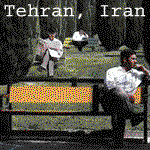Guantanamo Bay Deployment: Where Torture is a Day at the Beach
Feb 27 2005
By Kathleen T. Rhem, American Forces Press Service
NAVAL STATION GUANTANAMO BAY, Cuba -- This is not your typical deployment location in the war on terror. Troops here get to scuba dive in their off time and have an assortment of restaurants and bars to unwind in at the end of long days spent guarding enemy combatants.
The troops who manage the detention facility here belong to Joint Task Force Guantanamo. They're deployed for varying tour lengths from all services, both active and reserve components.
"They come here on deployment, and they're actually coming to a place that is not as bad as (many) deployments," said Navy Capt. Leslie J. McCoy, commander of the naval base.
JTF Guantanamo is a tenant organization on the base. The 2,200 JTF personnel live alongside the roughly 9,000 permanent-party sailors, family members, U.S. government civilians and contractors, and third-country nationals who reside and work here.
Sailors assigned to the base typically come for three-year tours and can bring their families. Deployment length for troops assigned to JTF Guantanamo depends on their service. Soldiers typically deploy for one year, Marines and sailors for six months, and airmen for four-month stints.
Living conditions vary considerably within the JTF. Enlisted servicemembers generally live in prefabricated individual buildings, which they call "houses" with a touch of cynicism. The shipping-container-like quarters each house four to six servicemembers. The troops typically divide the space as evenly as possible and then partition "rooms" by hanging blankets and shower curtains.
Each building contains a bathroom with a toilet and a sink. And men's and women's community latrines, with showers, sinks and toilet stalls, are located within each group of quarters.
Senior enlisted members and officers generally live in converted Navy family housing left over from when the base housed a larger population of permanent- party personnel. For instance, one two-bedroom apartment might be assigned to four junior officers.
Troops live and work together here depending on what their jobs are, but irrespective of their service. "I think it's an important part of how they form as a team to that they can do their mission here in the JTF," said Army Brig. Gen. Jay Hood, commander of JTF Guantanamo. "We have members assigned to the JTF that have come from assignments around the world, and so it's important that we allow them to live and work together and know each other and build as a team."
Living conditions for the servicemembers have improved considerably since the military began sending prisoners here more than three years ago. "If you go back and look at early pictures of the JTF, our troopers were all living in tents, eating out of temporary dining facilities," Hood said.
And officials continue to seek ways to improve living conditions. "Ideally what we'd like to do is have them all housed in barracks, so we're now looking at plans to do that," McCoy said. "We're trying to take as best care of (the JTF troops) as we can to ensure their quality of life is good. And part of that is to ensure they live in good rooms, good barracks or houses wherever they are."
"Gitmo" also is loaded with morale, welfare and recreation facilities and opportunities. Servicemembers can rent boats and fishing equipment, become certified in scuba diving, or spend their time off snorkeling and watching the vast array of aquatic wildlife that fills the crystal-clear waters of the bay and surrounding Caribbean Sea.
Aside from water sports, the base features a golf course -- troops generally play with hot-pink balls because white balls are too easy to lose in the gray desert landscape -- a brand-new miniature golf course, several gyms and outdoor sports fields, and two outdoor movie theaters. Considering the year-round warm weather and scant rainfall -- it rains only about three to five times a year here -- movies rarely are cancelled.
"They come to a small community. We provide a sense of normalcy for those who are (deployed) here," McCoy said. "They can come to our churches; they can take part in our college programs (and) the MWR facilities."
In turn, the captain explained, the base gets a lot from the JTF members deployed here. Since nearly 70 percent of Joint Task Force Guantanamo is made up of reserve-component members, they bring a lot of civilian-acquired skills with them.
"We get people here who are teachers, people who have different functions in their towns that they bring to Guantanamo Bay," McCoy said. "So actually the synergy that we have with the joint task force works out very well. We help support one another."
















0 Comments:
Post a Comment
<< Home